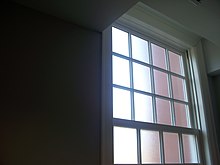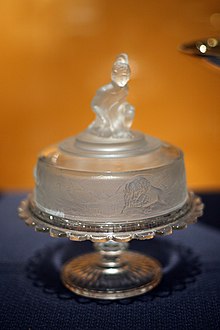Frosted glass
This article has multiple issues. Please help improve it or discuss these issues on the talk page. (Learn how and when to remove these messages)
|




Frosted glass is produced by the sandblasting or acid etching of clear sheet glass. This creates a pitted surface on one side of the glass pane and has the effect of rendering the glass translucent by scattering the light which passes through, thus blurring images while still transmitting light. It has 10–20% opacity.[citation needed]
General applications include:
- To achieve visual privacy while still allowing light to pass through.
- To create decorative patterns on plain glass by using wax or other inhibitors to retain transparent areas.
- To distribute light uniformly in a photographic contact printer.
- To create an airtight seal in tubes.[citation needed]
- Decorative, aesthetic, or artistic intent.
The frosted glass effect can also be achieved by the application of vinyl[disambiguation needed] film, used as a sort of stencil on the glass surface. "Photo-resist", or photo-resistant film is also available, which can be produced to mask off the area surrounding a decorative design, or logo on the glass surface. A similar effect may also be accomplished with the use of canned frosted glass sprays.
Recycling issue
[edit]As a rule, frosted glass is not suitable for recycling through glass bins.[1] This is because the etchants used to produce some frosted glass can leave chemical residue, which can interfere with the recycling process and spoil a whole batch. Frosted glass that was not acid-etched but rather produced by sandblasting is recyclable in principle, however, since it can be hard to tell how a given piece of frosted glass was manufactured, most recyclers will reject frosted glass absent a contract with specific assurances.
See also
[edit]- Cesia (visual appearance)
- Ground glass
- Ground glass joint
- Smart glass, of which some types are able to turn frosting on and off
References
[edit]- ^ "Differentiating Between Types of Glass – RecycleNation". 28 October 2010.
